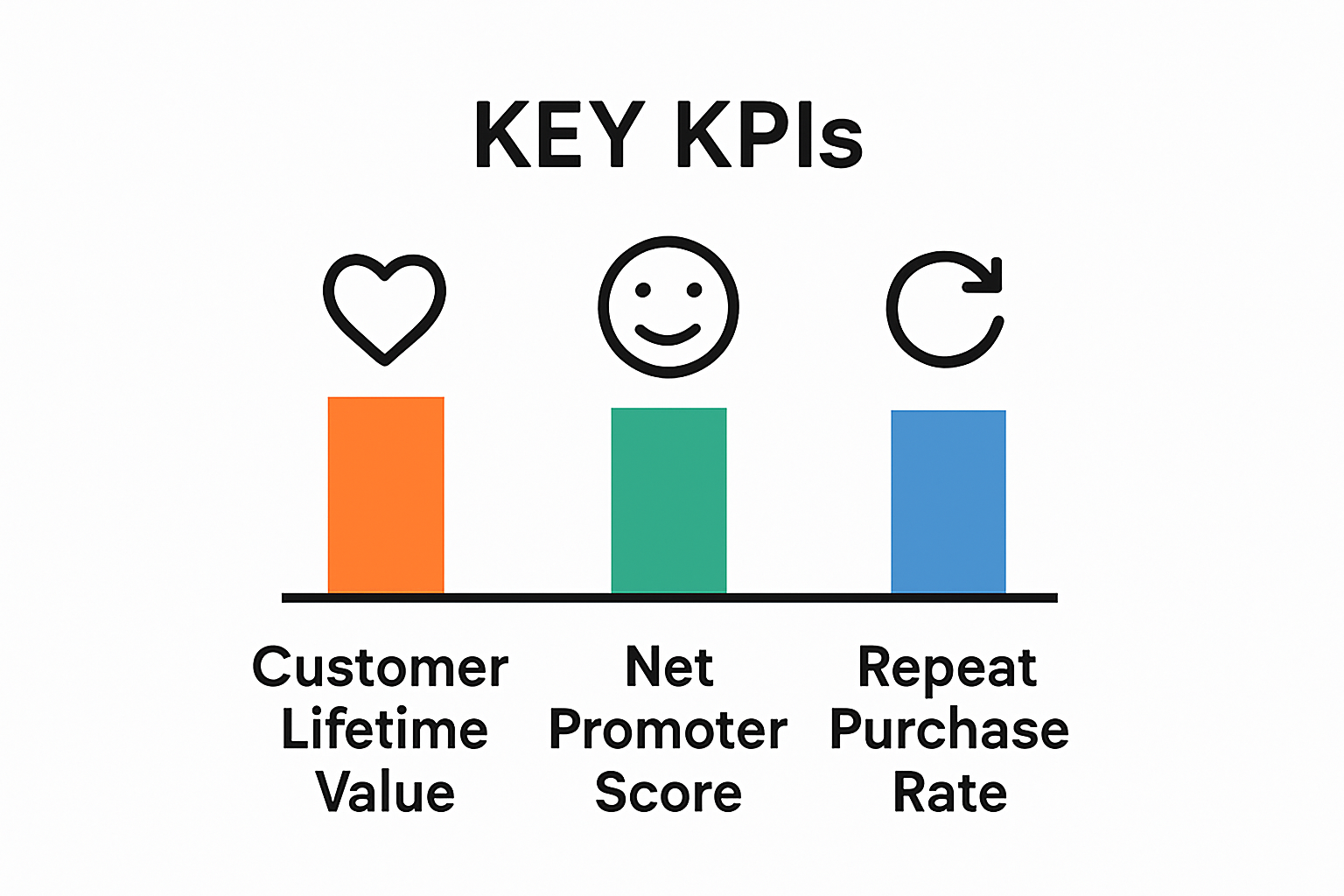Customer engagement sits at the heart of every business’s long-term growth plan and shapes how people feel about your brand. Most leaders think it’s just about sending emails or getting likes on social media, but that barely scratches the surface. The real secret is that businesses with high customer engagement see up to 23 percent higher revenue, profits, and retention than their competitors. It is not just about a transaction; it is about building a connection that keeps customers coming back for more.
Quick Summary
| Takeaway | Explanation |
|---|---|
| Customer engagement drives loyalty and referrals | Emotionally engaged customers are notably more likely to recommend your brand and make repeat purchases. |
| Personalization enhances customer relationships | Leveraging data for personalized experiences can lead to significant revenue increases. |
| Trust is essential for e-commerce | Building trust through security and transparency fosters lasting customer loyalty. |
| Measure engagement with specific metrics | Track performance indicators like customer lifetime value and retention rates to assess engagement success. |
| Integrate technology for better interactions | Use advanced tools like AI and analytics to create seamless and personalized customer experiences. |
What is Customer Engagement and Why It Matters
Customer engagement represents the dynamic relationship between a business and its customers, extending far beyond simple transactions. This intricate connection involves creating meaningful interactions that foster emotional attachment, loyalty, and sustained mutual value. Understanding customer engagement is crucial for businesses seeking to build lasting relationships and drive sustainable growth.
Defining Customer Engagement
At its core, customer engagement is about building genuine connections that transform passive consumers into active participants in a brand’s ecosystem. Research reveals that emotionally engaged customers are typically three times more likely to recommend a product and repurchase, demonstrating the profound impact of meaningful interactions.
Key characteristics of customer engagement include:
- Consistent and personalized communication
- Proactive problem solving
- Creating value beyond the initial product or service
- Encouraging two-way dialogue
- Demonstrating an authentic understanding of customer needs
The Strategic Importance of Customer Engagement
Engagement is not just a buzzword but a critical business strategy. By prioritizing customer relationships, companies can achieve significant competitive advantages. According to Gallup’s extensive research, businesses with high customer engagement levels outperform competitors by 23% in terms of revenue, profitability, and customer retention.
Successful customer engagement transforms customers from transactional participants to brand advocates. This shift occurs when businesses consistently demonstrate value, empathy, and a commitment to understanding individual customer preferences. The result is a powerful symbiotic relationship where customers feel genuinely understood and valued.
Ultimately, customer engagement is about creating an experience so compelling that customers choose to invest their time, trust, and resources in your brand repeatedly. It requires a holistic approach that integrates technology, personalization, and genuine human connection.
Key Concepts of Customer Engagement in E-Commerce
Customer engagement in e-commerce represents a sophisticated ecosystem of digital interactions that transcend traditional transactional relationships. Understanding these nuanced interactions is critical for online businesses seeking to build meaningful connections with their digital audience.
Digital Interaction Dimensions
E-commerce customer engagement is multifaceted, encompassing several interconnected dimensions that shape customer experience. Research from MIT Sloan Management Review highlights that successful digital engagement involves more than just technological interfaces but requires a holistic approach to customer interaction.
The primary dimensions of digital customer engagement include:
- Emotional Engagement: Creating feelings of connection and loyalty
- Cognitive Engagement: Providing meaningful content and experiences
- Behavioral Engagement: Encouraging active participation and repeat interactions
- Social Engagement: Facilitating community and shared experiences
Technological Enablers of Customer Engagement
Modern e-commerce platforms leverage advanced technologies to create more personalized and interactive customer experiences. Artificial intelligence, machine learning, and data analytics play pivotal roles in understanding and predicting customer behaviors.
Key technological strategies for enhancing engagement include:
- Personalized product recommendations
- Real-time customer support through AI chatbots
- Interactive product visualization tools
- Seamless omnichannel communication platforms
Building Trust in Digital Environments
Trust remains the foundational element of customer engagement in e-commerce. According to Forrester Research, businesses that successfully build digital trust can increase customer loyalty by up to 40% and reduce customer acquisition costs.
Building digital trust involves transparent communication, robust security measures, and consistent delivery of promised value. This means creating frictionless experiences that make customers feel secure, understood, and valued throughout their digital journey.
To clarify how each dimension of digital customer engagement contributes to the overall experience, the table below summarizes their core focus and impact.
| Engagement Dimension | Core Focus | Impact on Customer Experience |
|---|---|---|
| Emotional Engagement | Building feelings of connection | Increases loyalty and advocacy |
| Cognitive Engagement | Providing valuable content | Enhances brand perception and trust |
| Behavioral Engagement | Encouraging active participation | Boosts repeat interactions |
| Social Engagement | Facilitating community interactions | Fosters a sense of belonging |
Successful e-commerce customer engagement is not about implementing isolated tactics but creating a comprehensive ecosystem that prioritizes customer experience, technological innovation, and genuine human connection.
The Role of Technology in Enhancing Engagement
Technology has fundamentally transformed customer engagement from a transactional interaction to a sophisticated, personalized experience. Modern digital tools enable businesses to create deeper, more meaningful connections with customers by leveraging data, artificial intelligence, and advanced communication platforms.
Personalization through Advanced Analytics
Data-driven technologies have revolutionized how businesses understand and interact with customers. Gartner Research indicates that companies utilizing advanced personalization techniques can increase revenue by up to 15% by delivering precisely targeted experiences that resonate with individual customer preferences.
Key technological capabilities for personalization include:
- Real-time behavioral tracking
- Predictive customer preference modeling
- Dynamic content adaptation
- Contextual recommendation engines
- Individualized communication pathways
Artificial Intelligence and Customer Interaction
Artificial intelligence has emerged as a transformative force in customer engagement. AI-powered tools can analyze vast amounts of data, anticipate customer needs, and provide instantaneous, contextually relevant interactions. These technologies enable businesses to create scalable, intelligent communication systems that feel personal and responsive.
AI engagement technologies encompass:
- Intelligent chatbots
- Automated customer support systems
- Predictive customer journey mapping
- Natural language processing interfaces
- Sentiment analysis tools
Omnichannel Experience Integration
Modern engagement technologies focus on creating seamless experiences across multiple digital and physical touchpoints. According to McKinsey Digital, companies that successfully integrate omnichannel strategies can achieve customer satisfaction rates 20% higher than traditional single-channel approaches.
Successful technological integration requires a holistic approach that combines data insights, user-friendly interfaces, and responsive communication channels. By embracing these advanced technologies, businesses can transform customer engagement from a passive interaction into an active, dynamic relationship that continuously adapts to individual customer needs and preferences.
Measuring Customer Engagement: Metrics and Tools
Measuring customer engagement is a critical process that transforms abstract interactions into quantifiable insights. By understanding and tracking specific metrics, businesses can gain deep understanding of customer behavior, preferences, and potential areas for improvement.
Key Performance Indicators for Engagement
Harvard Business Review suggests that successful engagement measurement requires a comprehensive approach that goes beyond traditional metrics. Effective measurement involves capturing both quantitative and qualitative data points that reveal the depth of customer relationships.
Critical engagement metrics include:

- Customer lifetime value
- Repeat purchase rate
- Net promoter score
- Average session duration
- Customer retention rate
- Interaction frequency
- Conversion rates across different channels
Digital Engagement Tracking Technologies
Advanced digital tools have revolutionized how businesses track and analyze customer interactions. These technologies enable real-time monitoring and predictive analysis of customer behaviors, providing unprecedented insights into engagement patterns.
Key technological tracking mechanisms encompass:
- Web analytics platforms
- Customer relationship management systems
- Social media engagement trackers
- Behavioral heat mapping tools
- Machine learning predictive models
Interpreting Engagement Data
According to Forrester Research, raw engagement data becomes valuable only when transformed into actionable insights. Successful businesses develop sophisticated frameworks that translate metrics into strategic recommendations.
The most effective engagement measurement approaches combine multiple data sources, creating a holistic view of customer interactions.
The table below outlines key customer engagement metrics featured in the article, highlighting what each measures and how it informs business strategy.
| Engagement Metric | What It Measures | Strategic Insight Provided |
|---|---|---|
| Customer Lifetime Value | Total revenue from a customer over time | Predicts profitability and loyalty |
| Repeat Purchase Rate | Frequency of return purchases | Indicates customer satisfaction |
| Net Promoter Score | Likelihood to recommend the brand | Assesses loyalty and advocacy |
| Average Session Duration | Time spent per website visit | Reflects content or experience engagement |
| Customer Retention Rate | Percentage of retained customers | Measures success in fostering long-term ties |
| Interaction Frequency | Number of interactions per customer | Gauges engagement level and activity |
| Conversion Rate | Visitors converted to customers | Measures the effectiveness of engagement tactics |
Ultimately, customer engagement measurement is an ongoing process of learning, adapting, and refining strategies to create more meaningful and sustainable customer relationships.
Real-World Examples of Successful Customer Engagement Strategies
Customer engagement strategies are not theoretical concepts but practical approaches that transform business-customer relationships. By examining successful implementations across various industries, businesses can learn powerful techniques for creating meaningful connections.
Community-Driven Product Innovation
LEGO Group’s innovative approach demonstrates how customer engagement can drive product development. Their online platform allows fans to submit and vote on product ideas, creating a collaborative ecosystem where customers become co-creators. This strategy has generated over 1 million product submissions and cultivated an incredibly loyal community.
Key elements of LEGO’s engagement strategy include:
- Transparent submission process
- Democratic voting mechanism
- Direct customer involvement in product design
- Recognition for successful community designers
- Continuous feedback loops
Personalized Customer Experience Models
Successful engagement strategies often revolve around creating personalized, meaningful interactions. Nike’s membership program exemplifies this approach by offering tailored experiences that extend beyond traditional retail transactions.
Nike’s engagement strategy features:

- Personalized product recommendations
- Exclusive access to limited edition products
- Custom training programs
- Digital fitness tracking integration
- Reward points for community participation
Transformative Service Relationships
According to Harvard Business Review, the most successful engagement strategies transcend transactional interactions. Zappos, an online retailer, revolutionized customer service by empowering employees to create extraordinary customer experiences.
Zappos achieved this through:
- Unlimited customer support call times
- Emotional connection as a service priority
- Proactive problem solving
- Genuine, empathetic communication
- Employee training focused on relationship building
These real-world examples illustrate that successful customer engagement is not about implementing a single strategy but creating a holistic ecosystem that values customer input, personalizes experiences, and builds genuine connections.
Ready to Turn Engagement Insights Into Real Sales Growth?
Building strong customer engagement in e-commerce is no longer just a nice-to-have. As explained in this guide, businesses now need more than transactional relationships. You want to convert passive browsers into loyal brand advocates, but challenges like inconsistent messaging, lack of personalization, and scattered data make it hard to keep up. If you struggle to keep your communication proactive and on-brand or if your team is drowning in repetitive marketing work instead of creating meaningful connections, it is time to level up.

Experience how MarketingSuite.app brings AI-powered customer engagement to small and mid-size e-commerce shops. Simplify your tech stack, automate your campaigns, and deliver personalized content that boosts conversion, AOV and lifetime value. Get started today with the MarketingSuite landing page and see how smart automation can help you build stronger relationships, measure what matters, and act on insights faster. Your customers are ready for more—discover what true engagement feels like now.
Frequently Asked Questions
– What is customer engagement?
Customer engagement refers to the ongoing interactions between a business and its customers, aiming to build meaningful relationships that go beyond transactions. It involves creating emotional connections and fostering loyalty through personalized communication and proactive problem-solving.
– Why is customer engagement important for businesses?
Customer engagement is crucial as it drives growth and customer retention. Engaged customers are more likely to recommend products, repurchase, and maintain loyalty, leading to better revenue and profitability for businesses.
– How can technology enhance customer engagement in e-commerce?
Technology enhances customer engagement through personalized experiences, such as tailored product recommendations, real-time customer support, and interactive tools that facilitate seamless interactions across multiple channels.
– What metrics should businesses use to measure customer engagement?
Key metrics to measure customer engagement include customer lifetime value, repeat purchase rate, net promoter score, average session duration, and customer retention rate. These metrics help businesses understand and improve their customer relationships.
Recommended


Leave a Reply